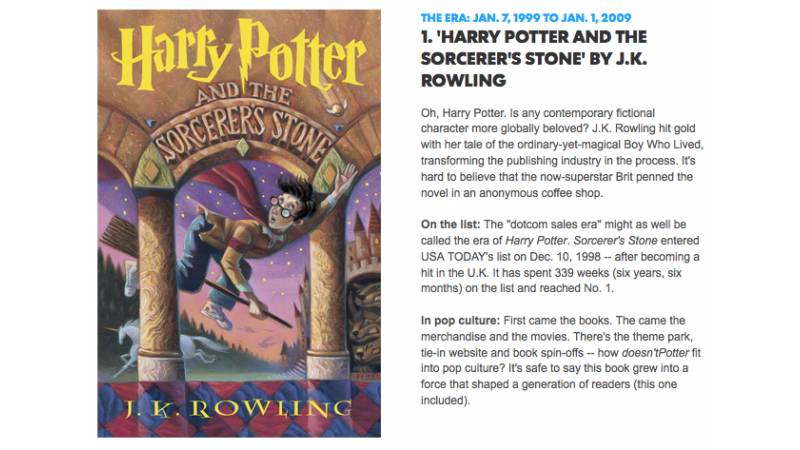 USA TODAY has been curating their bestseller list for 20 years now. In looking back at it, they wonder: what does the list say about what we read, and how we read it?
USA TODAY has been curating their bestseller list for 20 years now. In looking back at it, they wonder: what does the list say about what we read, and how we read it?
For starters, we sure have changed.
Back then, when USA TODAY began its best-seller lists, "J.K. Rowling was a struggling unknown writer teaching English in Portugal" and "Suzanne Collins was helping to write a children's TV show for Nickelodeon called Clarissa Explains It All." Today, of course, they're household names -- all thanks to books. They have a combined total of 225 million copies in print of their two bestselling series, Harry Potter and The Hunger Games (in case you needed a reminder!).
A lot more has changed in the past 20 years, though. For instance:
- The rise and fall of self-help: "Self-help and other advice titles were big during the first five years (1993-1998) when most books were bought in physical bookstores."
- Children's books shocked the world: "Rowling triggered Dickens-like excitement about reading and demolished the conventional wisdom about children's books in the second era (1999-2008), when online sales grew."
- Unexpected genres and formats: "Since 2009, fiction (as a percentage of best sellers) has risen to all-time highs and erotica went mainstream as e-books became the fastest growing part of the market."
 The story highlights Harry Potter as part of the "British kids' books" trend, noting how "Rowling's boy wizard zapped" the notion that kids' books had limited market appeal.
The story highlights Harry Potter as part of the "British kids' books" trend, noting how "Rowling's boy wizard zapped" the notion that kids' books had limited market appeal.
"Rowling reinvented the idea of a series," Scholastic's president and CEO Dick Robinson told USA TODAY. "Young kids love to read the same stories over and over again and older kids love to read new versions of the characters they know. What J.K. did so brilliantly was to age the characters in her books, so her readers grew up with them as the books became more complex."
Check out the whole story, and an awesome slidehow featuring some familiar photos, right here.
How would you say your reading has changed over the past two decades?



